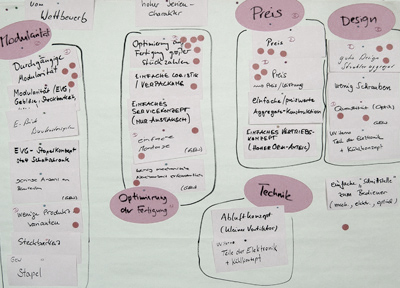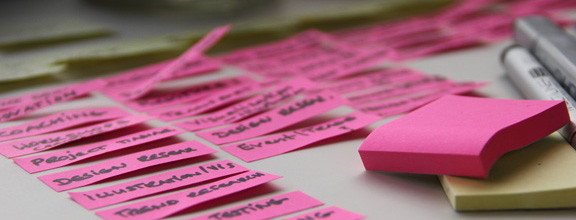Kick-off Workshop
The most effective way to collect all relevant information for the design and project brief at the beginning of an R&D project, especially with new clients, is to arrange a Kick-off workshop. This takes only up to a day, but enables to collect valuable information faster than any other process. It also introduces the main team members to each other and puts a face to a name in the organization.
The aim is to bring the development team together and hear the voice of all stakeholders very early on. If a design consultant meets only with one person or party valuable additional information oftem is discovered only later in the process - sometimes only by coincidence. Such information might have pointed towards a certain solution instantly, help avoid internal discussions or costly development dead-ends.
With all main parties in the same room a forum is created. It allows to hear what everyone has say, what they are concerned about, which ideas float already around in the organization and even learn about the own brand and products.
This process turned out to be valuable far beyond a direct development brief. Participants are often surprised to find that not only new ideas around a certain product are generated, but around marketing, brand strategy, services and more.
There is also the option to invite current or potential users in for certain parts of the session in order to get an unfiltered outside view and work on initial ideas with them. Not a full Co-creation workshop but a healthy portion of reality at a point when it is highly useful and easy to build into development aims.
This is not just a nice chat over a cup of coffee, but a highly structured and up to every detail planed event which uses an array of techniques from management training, adult education and creative industries. (Hence, we spend at least a day of planning such an event.)
The 'moderation' is one of the core techniques used in these workshops. The also called 'card technique' ensure that all participants get a chance to speak and contribute to find a solution, not just the loudest or most powerful voice in the room. Even though some international design consultancies make it appear as if they just invented a post-it version of the technique, it has been around since the 1970s in Germany. Neuland & Partner and Neuland GmbH became major players and innovators in the field since the 1980s.'Moderation' works with a set of rules using group interactions, card questions (today often replaced with post-it notes), clustering, evaluation, structured discussions, constructive
feedback and many other techniques which enable structure team/group meetings, seminars and ideation sessions. One of the underlying ideas is to make everything said or created instantly visible to all members of the group in order to reflect and build on the results.
Other components of the workshop come from de Bono inspired techniques like 6-3-5 and general creative tools like brain storming, role play or using collages, analogies, metaphors or rough and dirty modelling and quick sketching.
First rules for all of them is not to shoot down (critique) an idea instantly, but generate a diverse range for a filtering process afterwards. These filtering processes use strength and weakness analysis, feedback and majority models and more. Additionally they try to reveal the core value of an idea in order to convert - at first glance - even unfeasible solutions into such which might work in a new and unique (innovative) way or encourage new view points.
The workshop is structured in several stage and following the idea of divergent and convergent thinking. We however add a mapping (orientation) stage at the start. We try to identify where the company, its products and team members stand in relation to the market and general context (in their view).
We also allow a first drain of all the obvious and existing knowledge as well as identify issues or conflicting ideas around the project (following one of the Moderation rules of "disturbances have priority").
Participants often 'burn' to make important criteria, ideas or critical view points heard which can take the attention away from other things discussed if not documented early on.
Here a typical workshop structure:
Stage1: Introduction
Getting to know all involved team members and stakeholders. This includes an opportunity to express thoughts and aspirations around the project.
Define the task together and re-adjust project aims or development task (as there might be changes, shifts or differing views).
Stage 2 Mapping stage & Brain dump
Defining the Status-quo (as a orientation or inventory).
This is the point where typically briefing facts are gathered, including the overall motivation (company strategy) for the
project, the mission statement and company philosophy, but also how the product and system works, what needs to be improved and considered from a technical, financial, manufacturing, logistical,... point of view. We also gather existing or in the past considered ideas, hear out concerns and doubts around the project or individual aims.
If there is an opportunity we also ask for a live demonstration of product in use and sighting of production facilities (assembly area) with an extensive Q&A. All facts and questions are noted for later discussion or visualization in the workshop area. We also define brand and product values (but also mood and feel). Key words and visual are defined to identify differentiating factors and as a starting point for unique design features. This is combined with the comparison to competitors and their products. One of the questions we try to answer here already is which qualities of the individual products should be communicated through the design?
Stage 3: Divergent thinking (Creative segment)
After all the hard and soft facts have been collected, listed and documented we move forward to the creative part. We open up the flood gates for ideas, crazy or feasible, around before defined problems. In order to enable outside of the box thinking we often use speculative "What if..." scenarios in which a the usual rules and limits of the company, brand, technology and other boundaries do no longer apply. We found that working with constrains of a carefully constructed story/ scenario shifts the perspective and takes away the pressure of a simple free-flow or anything-goes ideation.
Stage 4: Convergent thinking
At this stage we usually have several boards filled with ideas which we start to read out, explain if unclear and cluster in theme groups. Participants are then allowed to rate, rank or vote for ideas usually done by Dot sticking. A certain amount of those ideas are then further analysed and discussed with a SWOT analysis or discussion round. Ideas are evaluated especially in regards of the approach of solving the core problem rather than obvious feasibility. If an approach has merit the group is asked what would have to be done to make the approach feasible. This often triggers very unexpected but realistic ideas.
Stage4: Summarize and conclude
All gathered criteria and insights from the mapping stage are summarized and less important or now redundant points taken out. A condensed list of ideas is compiled and some selected for further development. This often includes other action points not related to the product development project.
Stage5: Implementation plan
A list with action points (what), responsibilities (who) and delivery aims (when) are agreed on.
If necessary further research or information collection is decided.
Each participant gives feedback.
Post-workshop:
A full photo documentation is compiled and send to all participnts with an summary or final briefing document.

Typical moderation board with clustered and dot sticked cards

Participants cluster results from card question using post-it notes
How to get started

Note down some keywords around your project.
Use Mind map template to get started (download here). Additionally compile some visual material explaining
your project or inspirations.
Summarize essential information about the project you envision. This can be simply re-styling a product or technical concept, idea visualization, new product development, identify opportunities through market and trend reviews or new technology or material use. See project brief as a guide.
Get in contact with us to arrange an initial free consultation and quote. Feel free to propose what the work would be worth to you - we will look into reasonable proposals if the challenge is interesting to us.
Arrange a kick-off workshop with all parties/people involved in the project to collect all existing information, ideas, want and needs. Invite at least a representative of decision makers and strategic leaders, marketing, product planning, engineering (R&D), production/manufacturing and design team.
This will enable a flying start with clear communication and already a pile of feasible ideas to work on and test. We are trained moderators and enable a efficient and result-driven use of the groups time together.
Mindmap Project Brief